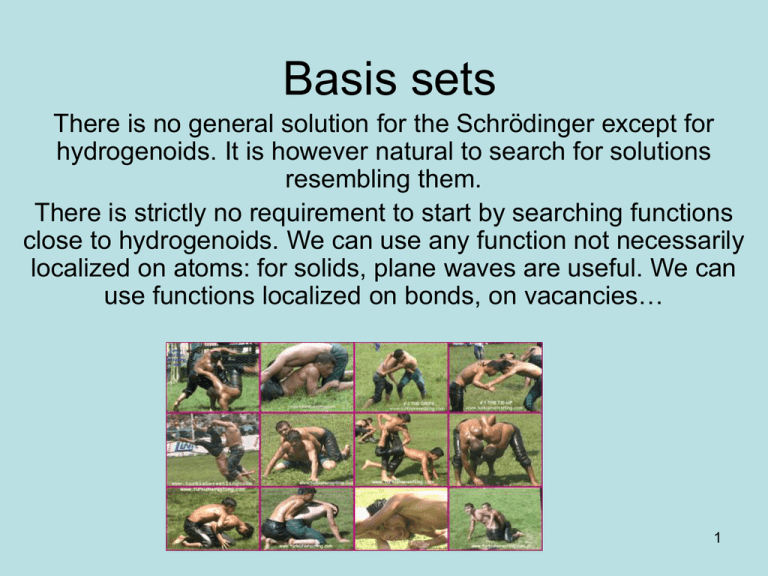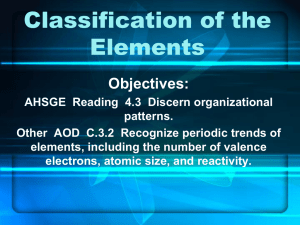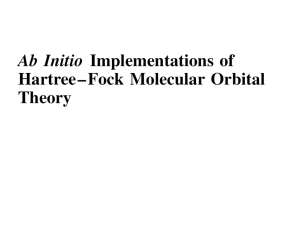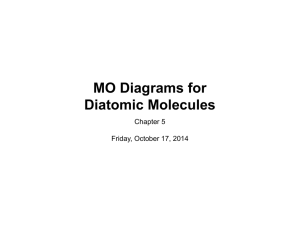basis-sets
advertisement

Basis sets There is no general solution for the Schrödinger except for hydrogenoids. It is however natural to search for solutions resembling them. There is strictly no requirement to start by searching functions close to hydrogenoids. We can use any function not necessarily localized on atoms: for solids, plane waves are useful. We can use functions localized on bonds, on vacancies… 1 Large basis sets What is stronger than a turkishman? Turkishmen What is better than a function? Several ones. Minimizing parameters combing several functions is generally an improvement (at the most, it is useless). Basis set associated with hydrogenoids: minimum basis set. more: extended basis set. 2 SCF limit Increasing the number of (independent) functions leads to improve the energy (variational principle). This improvement saturates. The limit is called SCF limit. This limit can be estimated by interpolation. 3 SCF convergence for H+ H2+ d a0 (Ả) E diss eV exp 2.0 (1.06 ) 2.791 1sH z=1 2.5 (1.32) 1.76 1sH z opt 2.0 (1.06) 2.25 + 2p 2.0 (1.06) 2.71 + more 2.0 (1.06) 2.791 4 H2 d a0 (Ả) E diss eV 1.40 (0.74) 4.746 1sH z=1 1.61 2.695 1sH z = 1.197 SCF Limit VB 1sH z=1.166 1.38 3.488 1.40 3.636 1.41 3.782 VB + p (93%s 7%p) A hundred of functions 1.41 4.122 1.40 D = 0.5 10-4 4.746 D = 10-6 exp 5 Variation of the Slater exponent • Hydrogen z=1.24 or z=1.30 smaller than z=1.0 • Diffuse orbitals: z small “soft” • contracted orbitals: z large “hard” z =Z/na0 < r> = a0 n(n+1/2)/Z = (n+1/2)/Z 6 Correlation The SCF energy is always above the exact energy. The difference is called the correlation energy, a term coined by Löwdin. A certain amount of electron correlation (Fermi correlation) is already considered within the HF approximation, found in the electron exchange term describing the correlation between electrons with parallel spin. The charge or spin interaction between 2 electrons is sensitive to the real relative position of the electrons that is not described using an average distribution. A large part of the correlation is then not available at the HF level. One has to use polyelectronic functions (VB method) or post Hartree-Fock methods (CI). 7 Incomplete Basis sets DZ: E(H2)=-1.128720 a.u. TZ+0.31(TZ-DZ): E(H2)=-1.134308 a.u. The term “ab initio” suggest no subjectivity. However the choice of the functions is arbitrary; The variational principle allows comparing several choices for quantitative results (not always desirable for understanding). Some functions may be redundant. Therefore, it is better to express the functions on a basis set of orthogonal and normalized functions. 8 Basis set superposition error, BSSE Since basis sets are incomplete, there is an error when calculating A + B → C. Indeed, it seems fair to use the same basis set for A, B and C. However in C, the orbitals of B contribute to stabilize A if it the basis set to describe A is incomplete. The same is true the other way round. Each monomer "borrows" functions from other nearby components, effectively increasing its basis set and improving the calculation of derived properties such as energy Thus A and B should be better described using the orbitals centered on the other fragment than alone. It follows that A+B is underestimated relative to C. 9 Basis set superposition error, BSSE (counterpoise method). The energy gain for the reaction is therefore overestimated. • For a diatomic formation, the solution is to calculate A and B using the full basis set for A+B. (B being a dummy atom when A is calculated). Ghost orbitals are orbitals localized where there is no nucleus (no potential). • For an interaction between 2 large fragments, there is a problem of choosing the geometry for A: that of lowest energy for A or that in the fragment A-B. The method is estimating the BSSE correction in the fragment of A-B and assuming that it is the correction for A. 10 Basis set superposition error, BSSE (Chemical Hamiltonian approach) The (CHA) replaces the conventional Hamiltonian with one designed to prevent basis set mixing a priori, by removing all the projector-containing terms which would allow basis set extension. Though conceptually different from the counterpoise method, it leads to similar results. 11 Basis set transformation, orthogonalization Starting from scratch, a set of functions is not necessarily orthogonal. Orthogonalization uses matrix transformations. There are 3 main orthogonalization processes: depends on the ordering; this may be useful a' 2 a' a 2 a 2 a a' 1 2 a 1 Löwdin Schmidt a' a' 2 a 1 Insensitive to the ordering. 2 a' 1 a Canonique 1 1 12 Orthogonal basis sets Advantage: - Leads to easier calculations (no rectangle terms). - objectivity (canonic or Löwdin) Inconvenient: - Interpretation becomes difficult; it is not possible to talk of AO occupancy if they are delocalized. Per-Olov Lowdin Uppsala 1916-2000 Orthogonalization:131950 hydrogenoids Solving Schrödinger equation for hydrogenoids leads to spatial functions: Y(r,q,f)= Nn,l rl Pn,l(r) exp(-Zr/n) R(q,f) • Nn,l is a normalization function (it contains the dimension a0-3/2) • rl is a power of r and Pn,l(r) a polynom of degree n-l-1 • exp(-Zr/n) makes the summation in the universe finite. • R(q,f) is an spherical harmonic function. 14 Slater-type orbitals (STOs ) 1930 The radial part appears as a simplification of that of the hydrogenoid. Y(r)= Nn,l rl exp(- z r/n*) Where John Clarke Slater 1900-1976 Nn,l is a normalization constant, z is a constant related to the effective charge of the nucleus, the nuclear charge being partly shielded by electrons. n* plays the role of principal quantum number, n = 1,2,..., The normalization constant is computed from the integral Hence There is no node for the radial part! 15 Slater-type orbital They are solution for a spherical potential V’ different from V allowing the same eigenfunctions and the same eigenvalues than the Schrödinger equation for the atom. V' = -Z/r + n* (n*-1)/2r2 or 2r2[E-V']-2r2[E-V’] = n*(n*-1) Let verify for Y2s= N r e-Zr/2: 16 Slater-type orbital Why this simplification? In LCAO, we make combinations of AOs. It is therefore useless to start by imposing the polynoms. What changes? The hydrogenoids are orthogonal <1sI2s>=0. (eigenfunctions associated with different quantum numbers). The Slater orbitals are not orthogonal. 1s+2s resembles the hydrogenoid 1s (no node) and 2s-1s resembles the 2s orbital (the combination makes the nodal surface appear. 17 Double zeta Using several Slater functions allows representing better different oxidation states. When there is an electron transfer, an atom could be A+, A° or A-. For a metal, often several atomic configurations are close in energy: s2d8, s1d9 or d10. This correspond to different exponents for the s and d AOs. Double and triple zeta functions 2 or 3 AOs adapted to one oxidation state each and allowing variation in a linear combination and flexibility. As soon as the reference to oxidation states disappears (Gaussian contractions) the terminology becomes less justified and just qualify the number of independent functions. 18 Gaussian functions rn-1 2 -ar e with N= (2a/p)0.75 have expressions close to Gaussians, N Slater. They are decreasing exponentials (more rapidly than Slaters), with different slope at r=0*. Close to r=req, differences are small. Gaussians are not as appropriate than Slaters but not so different to prevent considering them. The reason to use Gaussians is a computing facility. In the H-F method, many integrals (N4) involve the product of 4 orbitals. The product of two Gaussian is easily calculated; it is another Gaussian: * 19 Gaussian functions fitting Slater functions with z=1 A Gaussian orbital is a combination (contraction) of several individual Gaussian functions called primitive. A STO-NG orbital is a linear combination of N Gaussian fitting closely a Slater orbital. Minimal basis set: Sir John Anthony Pople 1925-2004 Nobel 1998 STO-1G e-0.27095 r2 STO-2G .678914 e-0.151623 r2 STO- 3G 0.444635. 0.535328 e-0.109818 r2 e-0.405771 r2 0.430129 e0.9518195 r2 0.154329 e-2.22766 r2 20 Fit of a Slater-type orbital by STO-NG 0, 6 Slater Amplitude A m plitu de 0, 5 STO3G 0, 4 0, 3 0, 2 STO1G 0, 1 -0,0 0 1 2 3 4 rayon (bohr) Radius (a.u.) 21 densityR adiale probability RadialD ensité de P robalibilté Fit of a Slater-type orbital by STO-NG 0, 05 STO1G 0, 04 STO3G 0, 03 SLATER 0, 02 0, 01 0, 00 0 1 2 3 rayon (bohr) Radius (a.u.) 4 22 Correspondance for z≠1 There is scaling factor: r →z2/z1 r When the Slater exponent is multiplied by z2/z1, the Gaussian exponent is multiplied by (z2/z1)2. e-zr = 2 -ar e = 2 -[√ar] e → (z2/z1) = (a2/a1)0.5 For H, the Slater exponent is multiplied by 1.24; those of the gaussian function are multiplied by 1.242= 1.5376 For C, the Slater exponent is multiplied by 1.625; those of the gaussian function are multiplied by 1.6252= 2.640625 23 Minimal basis set and split valence basis set. STO-3G has been a long time used; with improvement of computing facilities, this is not the case nowadays in spite of the simplicity of using minimal basis. One way to improve accuracy is taking more functions. Releasing all contractions (N functions instead of 1 linear combination) is expensive. We can split the Gaussian into two sets. The partition may make groups or isolate the outermost primitive. The first procedure perhaps involves larger energy contribution but the second one is more chemical. The flexibility in reaction is necessary for the electron participating to the transformation (chemical reaction). If only the outermost primitive is isolated, we have the split-valence basis set named N-X1G by Pople. 24 Split valence basis set; N-X1G Core orbitals are represented by a single orbital with N primitives. Valence orbitals are represented by 2 orbitals: one orbital with X primitives and one diffuse orbital. Sir John Anthony Pople 1925-2004 Nobel 1998 basis 3-21G 4-31G 6-31G core 3 4 6 valence valence 2 1 3 1 3 1 25 Forget about Slater : Minimal basis set Huzinaga and Dunning One way to obtain contraction is making a full calculation with no contraction and using the MO coefficients for contraction. Basis set for O 26 Alternative partitioning for extended basis sets; Huzinaga and Dunning The basis set for O [9s5p/3s2p] by Dunning means that there are 3 s orbitals (using 1, 2 and 6 primitives) and 2 p orbitals (using 4 and 1 primitives). The “1s” orbital is represented by the first orbital (1 primitive). The basis set for O2- [13s7p/5s3p] by Pacchioni and Bagus means that there are 5 s orbitals (using 6, 2, 1, 2 and 1 primitives) and 2 p orbitals (using 4, 2 and 1 primitives). The “1s” orbital is represented by the first orbital (6 primitives). DZHD Double-Zeta Huzinaga-Dunning DTZHD Double-triple-Zeta Huzinaga-Dunning: The contraction generates several orbitals and is qualified a N zeta even if this is more mathematics than physics: the relation with Slater orbitals and oxidation states desappears. 27 cc-pVDZ and others These basis are designed to converge systematically to the complete basis set (CBS) limit using extrapolation techniques. The 'cc-p', stands for 'correlation consistent polarized' and the 'V' indicates they are valence only basis sets. Examples of these are: cc-pVDZ - Double-zeta, cc-pVTZ - Triple-zeta, cc-pVQZ - Quadruple-zeta, cc-pV5Z - Quintuple-zeta, aug-cc-pVDZ, ( Augmented versions of the preceding basis sets with added diffuse functions)... H-He B-Ne Al-Ar cc-pVDZ [2s1p] → 5 func. [3s2p1d] → 14 func. [4s3p1d] → 18 func. cc-pVTZ [3s2p1d] → 14 func. [4s3p2d1f] → 30 func. [5s4p2d1f] → 34 func. cc-pVQZ [4s3p2d1f] → 30 func. [5s4p3d2f1g] → 55 func. [6s5p3d2f1g] → 59 func. 28 Polarized Basis sets For H2, 7% of p improved the total energy from 3.782 eV to 4.122 eV. The molecular potential is not spherical around each atom. The directionality is provided by p-type orbitals. Polarization functions consists to add “l+1” functions: External valence shell s p d polarization p d f Pople’s notation 6-31G**: first asterisk “heavy atoms”; second asterisk: p-type on H 29 6-21G(df) add d and f functions and He Basis sets for anions, 6-31++G** Anions require diffuse orbitals and are more difficult to calculate “in gas phase” than neutral or cationic species. Usually one can use more diffuse (smaller) exponents. The addition of diffuse functions, denoted in Pople-type sets by a plus sign, +, and in Dunning-type sets by "aug" (from "augmented"). Two plus signs indicate that diffuse functions are also added to light atoms (hydrogen and helium). 30 Rydberg functions These orbitals are much more diffuse than the others associated with the valence. They are associated with loosely tight electrons occupying atomic orbitals with a quantum number n+1 31 Pseudopotentials Core orbitals do not participate to much to chemistry and it is more useful and simpler to calculate only the valence. Then core electron interactions are replaced by a pseudopotential. The pseudopotential is an effective potential constructed to replace the atomic allelectron potential such that core states are eliminated and the valence electrons are described by nodeless pseudowavefunctions. Only the chemically active valence electrons are dealt with explicitly, while the core electrons are 'frozen' Motivation: Reduction of basis set size Reduction of number of electrons Inclusion of relativistic and other effects 32 33 Pseudopotentials Small core – Large core: More or less electrons can be frozen. In a small core, not only the valence electrons are treated explicitly but also the outer shell beneath. Norm-conserving pseudopotentials are such that the pseudo- and all-electron valence eigenstates have the same energies and amplitude (and thus density) outside a chosen core cutoff radius rc. Pseudopotentials with different cutoff radius are said to be harder or softer. Softers are more rapidly convergent, but at the same time less transferable, that is less accurate to reproduce realistic features in different environments. Ab initio? The expression of the pseudopotential is a parameterized expression fitted on experiment. It needs some estimated formula and not the only use of Schrödinger equation. As for DFT, it is ab-initio in the sense of not introducing empirical data to evaluate integrals, but it does through the fitting of a potential. History: First introduced by Hellmann in the 1930s. By construction of this pseudopotential, the valence wavefunction is guaranteed to be orthogonal to all 34 the core states. Used with plane waves to avoid introducing an excessive number of PW to represent the oscillations close to the nucleus. 35 Step calculations To save calculation efforts, on can use different accuracy for optimization of geometry and calculation of properties on the optimized geometry. UHF/3-21G(d) means that the geometry was optimized using UHF/3-21G(d) and the final result was calculated using UB3LYP/6-31G(d) 36 Counterintuitive effect Hij-ESij is usually negative since Hij is larger than -ESij. For high S values and low lying orbitals this can be not true. Then since interacting terms change sign, the out-ofphase combination become lower in energy than the in-phase combination. The change of sign also imposes some negative population of atomic orbitals and some values exceeding 2. Mulliken population are less reliable when the basis set is extended, since there are large S values between two functions that have nearly the same localization. 37 How many AOs? How many occupied MOs? How many vacant MOs? For C2H4 # MOs # occ # vac EHT STO-3G 3-21G 4-31G 6-31-G** PS-31G 38 How many AOs? How many occupied MOs? How many vacant MOs? For C2H4 EHT # MOs 12 # occ 6 # vac 6 STO-3G 14 8 6 3-21G 20 8 12 4-31G 20 8 12 6-31-G** 42 8 34 PS-31G 6 12 18 39






